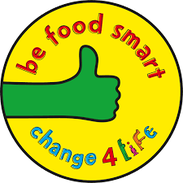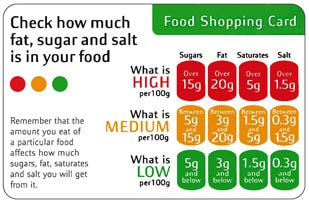Sugar - Fats - Additives
Take a look around and you will see that we are currently gripped by what is fast becoming a worldwide obesity epidemic. The World Health Organization states that being overweight is the fifth leading cause of global death and is a major contributory factor to many other life threatening diseases including Type 2 Diabetes and Heart Disease. Many of us are oblivious to the amount of fat, sugars and preservatives that are added to the foods that we eat and one of the biggest culprits is fast food. The trouble is that fast food is available on virtually every street corner and as unhealthy as it is, many of us find it hard to say no. It may be quick and convenient and even taste pretty good but have you ever thought what you are actually putting into your body or the damage that it may be doing to your heart?
Love Your Heart
Fast Food
A Strawberry Milkshake for instance from a well know fast food chain contains over 50 different chemicals and their fries contain a chemical called TBHQ (E319) which is a petroleum-based ingredient similar to lighter fluid used as a preservative. Sugar, saturated fat and chemicals are everywhere and are really bad for the human body. As we do not actually know exactly what is being added to the fast foods that we eat it should be eaten only occasionally.
How much sugar should we eat?
Government guidelines recommend that 'free' or added sugars should make up no more than 5% of the energy (calories) that we get from food and drink each day. That is a maximum of 30 grams of added sugar a day for adults, which is roughly seven sugar cubes.
Children should have less – no more than 19 grams a day for children aged 4 to 6 years old (5 sugar cubes), and no more than 24 grams (6 sugar cubes) for children aged 7 to 10 years old.
Sugar is added to many of the foods that we eat particularly such things as sweets, cakes, biscuits, chocolate, and some fizzy drinks and juice drinks for example – a can of cola can have as much as 9 cubes of added sugar.
The Change 4 Life Sugar Smart App
Designed to show quickly and easily how much sugar is in the food and drink you’re having.
Just scan the bar-code to see how much sugar it contains.
Children should have less – no more than 19 grams a day for children aged 4 to 6 years old (5 sugar cubes), and no more than 24 grams (6 sugar cubes) for children aged 7 to 10 years old.
Sugar is added to many of the foods that we eat particularly such things as sweets, cakes, biscuits, chocolate, and some fizzy drinks and juice drinks for example – a can of cola can have as much as 9 cubes of added sugar.
The Change 4 Life Sugar Smart App
Designed to show quickly and easily how much sugar is in the food and drink you’re having.
Just scan the bar-code to see how much sugar it contains.
A Guide to Decoding Nutritional Information
The Traffic Light System on the front of most packaging is a great way to know at a glance if your food choice is a good option. This will show instantly if it is high in fat, saturated fat, sugar and/or salt.
Any product that has green lights is a healthy choice that you can enjoy regularly whereas any food that has red lights is not good for you or for weight loss and should be consumed only occasionally if at all.
Any product that has green lights is a healthy choice that you can enjoy regularly whereas any food that has red lights is not good for you or for weight loss and should be consumed only occasionally if at all.
Certain products focus on their positives to distract you from their short-comings.
Some examples include:
Snack foods: Being ‘made with vegetables’ (e.g. root vegetable crisps) or ‘real fruit’ (e.g. strawberry snack bars) doesn't guarantee much of these ingredients – it could be as little as 1-5%. Most of these kinds of snack foods are full of ‘empty’ calories (i.e. they’re short on nutrition). So, you won’t be surprised to find that the best source of vegetables and fruit are, um, vegetables and fruit...
Sugary breakfast cereals: Impressive quantities of ‘essential vitamins and minerals’ doesn’t discount for the fact that some cereals are high in sugar and relatively low in fibre. Don’t be swayed.
Organic, natural and health foods: None of these terms have any impact on the energy density of a food, nor are they necessarily any better for you.
Confectionery: Just because it’s ‘100% natural’ or includes ‘fresh fruit’ doesn’t make it any lower in calories or any better for you, either.
Sugary breakfast cereals: Impressive quantities of ‘essential vitamins and minerals’ doesn’t discount for the fact that some cereals are high in sugar and relatively low in fibre. Don’t be swayed.
Organic, natural and health foods: None of these terms have any impact on the energy density of a food, nor are they necessarily any better for you.
Confectionery: Just because it’s ‘100% natural’ or includes ‘fresh fruit’ doesn’t make it any lower in calories or any better for you, either.
Reading Food Labels
When we go food shopping we can actually see for ourselves what we are buying but we should also get into the habit of reading the small nutrition labels on the packaging.
Here are some of the terms that we are faced with every day when food shopping.
Fat free – less than 0.5g of fat per serving
Low fat – no more than 3g of fat per 100g
Reduced fat – at least 25% less fat than the original product
Lite or Light – the product must be at least 30% lower in at least one area, such as fat or calories, compared to that of a standard product. Be sure to always check the packaging though as definitions can vary between brands.
Lean – less than 10g of fat and 4.5g of saturated fat per serving and per 100g of meat, poultry or fish.Extra lean – less than 5g of fat and 2g of saturated fat per serving and per 100g of meat, poultry or fish.
Low fat – no more than 3g of fat per 100g
Reduced fat – at least 25% less fat than the original product
Lite or Light – the product must be at least 30% lower in at least one area, such as fat or calories, compared to that of a standard product. Be sure to always check the packaging though as definitions can vary between brands.
Lean – less than 10g of fat and 4.5g of saturated fat per serving and per 100g of meat, poultry or fish.Extra lean – less than 5g of fat and 2g of saturated fat per serving and per 100g of meat, poultry or fish.


